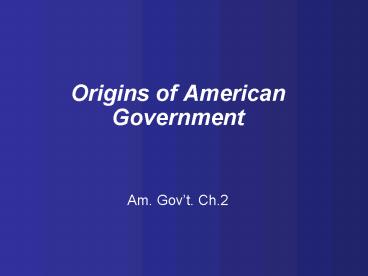Origins of American Government - PowerPoint PPT Presentation
1 / 13
Title:
Origins of American Government
Description:
... the practices and to organize boycotts and other act of protest. ... 2) Congress sent a Declaration of Rights to the King, protesting taxes and restrictions. ... – PowerPoint PPT presentation
Number of Views:577
Avg rating:3.0/5.0
Title: Origins of American Government
1
- Origins of American Government
- Am. Govt. Ch.2
2
- Our Political Beginnings
- A. Basic Concept of Government
- 1) Ordered Govt. colonists from
England saw the orderly regulation of their
relationships with one another. - 2) Limited Govt. colonists brought with
them the idea that govt. should not be
all-powerful. - 3) Representative Govt. colonists
believed that govt. should serve the will
of the people
3
- B. Landmark English Documents
- 1) Magna Carta established the
principle of limited gov. and fundamental
rights of English citizens. - 2) The Petition of Right limited the
monarchs authority and elevated the power
of Parliament while extending the rights
of the individual. - 3) The Bill of Rights redefined the
rights of Parliament and the rights of
individuals.
4
- C. Government in Colonies
- 1) Royal Colonies subject to the
control of the crown and run by appointed
governors, who were advised by councils. - 2) Proprietary Colonies owned by wealthy
individuals who appointed governors, who
were advised by councils. - 3) Charter Colonies governed by the
colonists themselves through elected
governors, who were advised by councils.
5
- The Coming of Independence
- Royal Control
- Control of the colonies was relaxed because of
the distance from England to America. - Each colonial legislature assumed broad lawmaking
powers. - After 1760, Parliament imposed new taxes
provoked colonial protest of no taxation without
representation!
6
- B. Growing Colonial Unity
- 1) Early Attempts 1600s some colonies
banded together temporarily to defend
themselves, but the need passed and unity
failed. - 2) The Albany Plan Franklins Albany of
Union called for annual meeting to deal with
issues of common concern, but the
colonial governments turned down the
plan. - 3) The Stamp Act Congress harsh tax and
trade policies caused colonists to meet
to denounce the practices and to organize
boycotts and other act of protest.
7
- C. The First Continental Congress
- 1) Intolerable Acts (1774) caused
colonists to send delegates to a
meeting to discuss matters and to make
plans for action. - 2) Congress sent a Declaration of
Rights to the King, protesting taxes
and restrictions. - D. The Second Continental Congress
- 1) Congress met again (1775), but now
the revolution had begun.
8
- 2) Congress organized a govt. and established an
army, led by George Washington. - 3) Congress served as govt until the Articles of
Confederation went into effect. - 4) Congress was unicameral, exercising both
legislative and executive powers.
9
- E. Declaration of Independence
- 1) The Declaration announced the
independence of the United States from
Great Britain and listed the reasons for
rebellion. - 2) The Declaration proclaimed equality
and rights of people. - F. The First State Governments
- 1) Most States wrote and adopted their own
constitutions.
10
- G. Common Features of New States
- 1) Popular Sovereignty the States govt
existed by the consent of the governed. - 2. Limited Gov. the power of the
States govt were restricted. - 3) Civil Rights and Liberties each new
state govt was organized with independent
branches of govt.
11
- III. The Critical Period
- A. The First National Constitution
- 1) The Articles of Conf. formed a
confederation among the States. - 2) Govt Structure Govt under the
Articles was a unicameral legislature with
no executive or judiciary. - 3) Powers of Congress most powers
related to common defense. - 4) State Obligations States agreed to
accept several obligations to the central
govt but retained many powers of govt
for themselves.
12
- 5) Weakness the govt lacked the power
to tax, or to regulate trade between the
States, and had no power to make the States
obey the Articles. - B. The Critical Period, the 1780s
- 1) Disputes among the States highlighted
the need for a stronger, more effective
National Govt - 2) Economic chaos also resulted from a
weak central govt - C. The Meetings at Mount Vernon and Annapolis
- 1) majority of States called for a
convention Philadelphia to improve the
Articles of Conf.
13
- 2) This meeting became the Constitutional
Convention.

